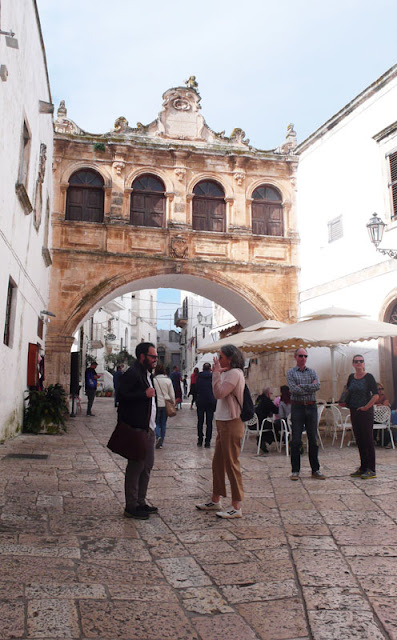First we went into the surrounding fields to admire the olive trees,
some of them over two thousand years old.
Several families used to live within the compound. (An old Fiat car from the '30's or '40's was stored under one of the arches.)
A small church served the needs of all the occupants of the masseria.
We were able to poke about the outbuildings and learn about the earlier methods of processing the oil.
Then it was time for a blind tasting of three different oils and a lesson in how to read the labels when buying olive oil. The secret, apparently, is to look for the information that the olive oil has been produced and bottled on site. If in doubt you can get it shipped from Brancati - it tastes delicious!
OSTUNI
After driving though the flat valley of d'Itria we were suddenly climbing steeply uphill to the white city of Ostuni, built on the rocky outcrop as a means of protection against invaders. The column in the central square, built in 1771. Atop it stands Sant'Oronzo. It used to be even higher but after falling down and being rebuilt the column lost a few layers!
Beautiful creamy stone and fine decoration on the public buildings.
This beautiful structure, Porta San Demetrio, is one of Ostuni's medieval gates.
The narrow streets are altogether more humble, but very charming.
After wandering the maze of little streets we headed down to walk the city walls. We were greeted by an up draught of cooling air as we stepped out to overlook the valley. It must be a blessing in the heat of the summer.
We spotted this abandoned palazzo beneath the city walls. I hope someone will rescue it.
It was a lovely place to stroll.






























Kinell. What a beautiful locale. I am trying not to be spitefully jealous.
ReplyDeleteKinell, u swearin, bro? Go on, be jealous, it was fabulous.
DeleteThat looks like a lot of walking uphill and stairs but definitely worth the effort.
ReplyDeleteGentle meandering, Maybe, no effort required. You can see the wind lift my daughter's hair as she walked down to the city walls.
Delete